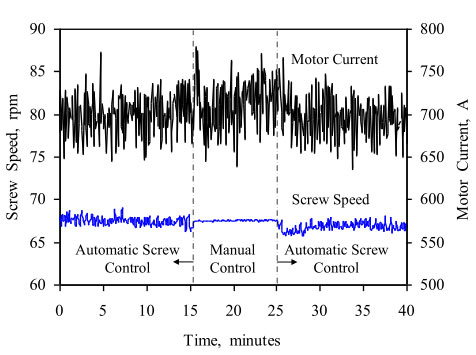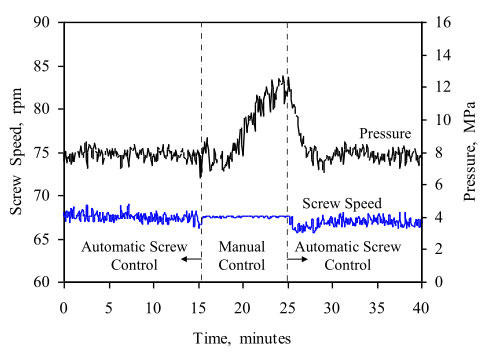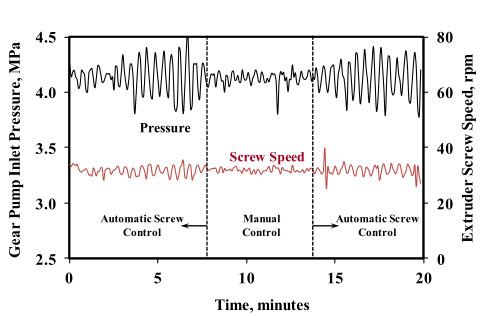
Gear pump pressure control is so important that a poor control algorithm for the pump can cause some variation in the extruder screw speed, causing large variations in the inlet pressure to the pump.
This type of control-induced surging can occur even though the process as designed is inherently stable. To determine if the control algorithm is inducing the surging, the screw speed of the extruder should be operated in a manual mode and at a constant speed. If the controller is inducing the surging, placing the process in manual control mode will stabilize the process.
Transient process data were collected for an extruder with a downstream gear pump. For this case, the control algorithm was controlling the speed of the screw such that the inlet pressure to the pump was maintained at 8 MPa for a polycarbonate (PC) resin. Although the variation in screw speed was not excessive at 67+1.5 rpm, the variation in motor current seemed quite high at 540+90 A. At about 16 minutes into the run, the extruder was switched from automatic to manual screw control; i.e., the screw speed was held constant at 67 rpm. As shown by the data in Figure 1, the motor current variation was unchanged, indicating that the screw speed control algorithm was not inducing the variation in the motor current. During the period that the screw speed was held constant, the pressure to the inlet of the pump slowly increased, as shown in Figure 2. This pressure was increasing because the screw was operating at a speed that delivered a rate slightly higher than that needed by the pump. When the control was placed back into the automatic mode, the screw speed was decreased initially to compensate for the higher than desired pump inlet pressure.

Figure 1. An extrusion process with a downstream gear pump with the screw operating in inlet pressure control and followed by the screw in manual operation (constant screw speed).

Figure 2. Pressure at the inlet to the gear pump for the data presented in Figure 1. The pressure increased during manual control because the flow rate of the extruder was slightly higher than the rate of the pump.
The large level of variation in the motor current during constant screw speed control suggests that the extrusion process was unstable, and the control algorithm was not the root cause for the variation in the motor current. The root cause and technical solution for mitigating the surge are provided elsewhere.
In another case, a single-stage extruder with a gear pump running a low density polyethylene (LDPE) resin was operating with a pressure oscillation at the discharge of the extruder. Like the previous case, it was not known if the extruder or the control algorithm for the gear pump was causing the instability. The pressure oscillation during the unstable period is shown in Figure 3 for the first 7 minutes of data collection. Like before, the gear pump controller was placed into manual mode such that the extruder screw speed was held constant. As shown in Figure 3, the pressure at the inlet to the gear pump was relatively stable when the screw speed was in manual control. When the control was turned back on, the pressure variations resumed. These data indicate that the control algorithm was causing the pressure surges to the inlet of the gear pump. In this case the proportional gain of the controller was set too high for the process. When the gain was reduced, the process became very stable with the pump in automatic control mode.

Figure 3. Process dynamics for a gear pump with a poorly designed control system.
Placing the screw speed controller in manual mode is recommended when minor levels of flow surging are observed with a process where the screw speed is controlled from the inlet pressure of a gear pump. This procedure will correctly guide the troubleshooting process to focus on the extruder or the gear pump.